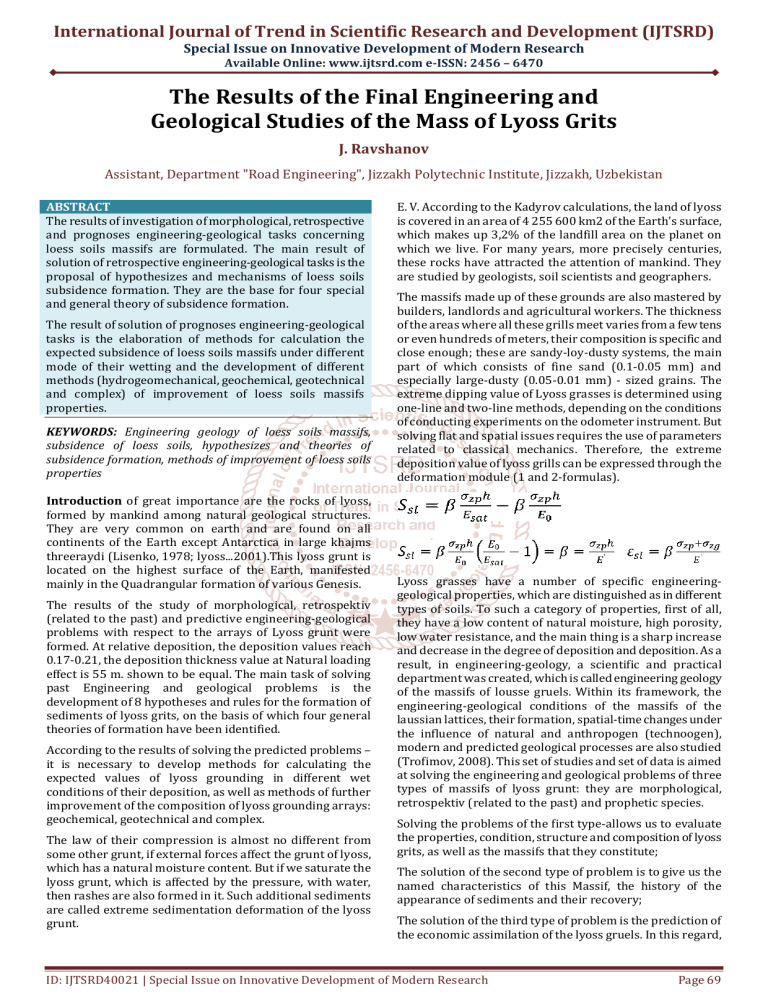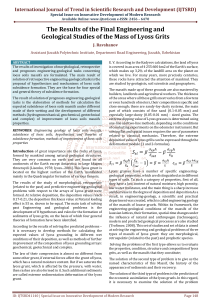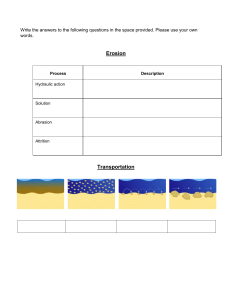
International Journal of Trend in Scientific Research and Development (IJTSRD)
Special Issue on Innovative Development of Modern Research
Available Online: www.ijtsrd.com e-ISSN: 2456 – 6470
The Results of the Final Engineering and
Geological Studies of the Mass of Lyoss Grits
J. Ravshanov
Assistant, Department "Road Engineering", Jizzakh Polytechnic Institute, Jizzakh, Uzbekistan
ABSTRACT
The results of investigation of morphological, retrospective
and prognoses engineering-geological tasks concerning
loess soils massifs are formulated. The main result of
solution of retrospective engineering-geological tasks is the
proposal of hypothesizes and mechanisms of loess soils
subsidence formation. They are the base for four special
and general theory of subsidence formation.
The result of solution of prognoses engineering-geological
tasks is the elaboration of methods for calculation the
expected subsidence of loess soils massifs under different
mode of their wetting and the development of different
methods (hydrogeomechanical, geochemical, geotechnical
and complex) of improvement of loess soils massifs
properties.
KEYWORDS: Engineering geology of loess soils massifs,
subsidence of loess soils, hypothesizes and theories of
subsidence formation, methods of improvement of loess soils
properties
Introduction of great importance are the rocks of lyoss,
formed by mankind among natural geological structures.
They are very common on earth and are found on all
continents of the Earth except Antarctica in large khajms
threeraydi (Lisenko, 1978; lyoss...2001).This lyoss grunt is
located on the highest surface of the Earth, manifested
mainly in the Quadrangular formation of various Genesis.
The results of the study of morphological, retrospektiv
(related to the past) and predictive engineering-geological
problems with respect to the arrays of Lyoss grunt were
formed. At relative deposition, the deposition values reach
0.17-0.21, the deposition thickness value at Natural loading
effect is 55 m. shown to be equal. The main task of solving
past Engineering and geological problems is the
development of 8 hypotheses and rules for the formation of
sediments of lyoss grits, on the basis of which four general
theories of formation have been identified.
According to the results of solving the predicted problems –
it is necessary to develop methods for calculating the
expected values of lyoss grounding in different wet
conditions of their deposition, as well as methods of further
improvement of the composition of lyoss grounding arrays:
geochemical, geotechnical and complex.
The law of their compression is almost no different from
some other grunt, if external forces affect the grunt of lyoss,
which has a natural moisture content. But if we saturate the
lyoss grunt, which is affected by the pressure, with water,
then rashes are also formed in it. Such additional sediments
are called extreme sedimentation deformation of the lyoss
grunt.
E. V. According to the Kadyrov calculations, the land of lyoss
is covered in an area of 4 255 600 km2 of the Earth's surface,
which makes up 3,2% of the landfill area on the planet on
which we live. For many years, more precisely centuries,
these rocks have attracted the attention of mankind. They
are studied by geologists, soil scientists and geographers.
The massifs made up of these grounds are also mastered by
builders, landlords and agricultural workers. The thickness
of the areas where all these grills meet varies from a few tens
or even hundreds of meters, their composition is specific and
close enough; these are sandy-loy-dusty systems, the main
part of which consists of fine sand (0.1-0.05 mm) and
especially large-dusty (0.05-0.01 mm) - sized grains. The
extreme dipping value of Lyoss grasses is determined using
one-line and two-line methods, depending on the conditions
of conducting experiments on the odometer instrument. But
solving flat and spatial issues requires the use of parameters
related to classical mechanics. Therefore, the extreme
deposition value of lyoss grills can be expressed through the
deformation module (1 and 2-formulas).
Lyoss grasses have a number of specific engineeringgeological properties, which are distinguished as in different
types of soils. To such a category of properties, first of all,
they have a low content of natural moisture, high porosity,
low water resistance, and the main thing is a sharp increase
and decrease in the degree of deposition and deposition. As a
result, in engineering-geology, a scientific and practical
department was created, which is called engineering geology
of the massifs of lousse gruels. Within its framework, the
engineering-geological conditions of the massifs of the
laussian lattices, their formation, spatial-time changes under
the influence of natural and anthropogen (technoogen),
modern and predicted geological processes are also studied
(Trofimov, 2008). This set of studies and set of data is aimed
at solving the engineering and geological problems of three
types of massifs of lyoss grunt: they are morphological,
retrospektiv (related to the past) and prophetic species.
Solving the problems of the first type-allows us to evaluate
the properties, condition, structure and composition of lyoss
grits, as well as the massifs that they constitute;
The solution of the second type of problem is to give us the
named characteristics of this Massif, the history of the
appearance of sediments and their recovery;
The solution of the third type of problem is the prediction of
the economic assimilation of the lyoss gruels. In this regard,
ID: IJTSRD40021 | Special Issue on Innovative Development of Modern Research
Page 69
International Journal of Trend in Scientific Research and Development (IJTSRD) @ www.ijtsrd.com eISSN: 2456-6470
it is necessary to examine the solution of the problem
predicted in the study of construction skills in the arrays of
lyoss grasses as an examination.
It is permissible for us to definitely point out a few scholars
who have added their great efforts and contributions in the
engineering-geological studies of these peculiar massifs of
lysos grunt. They Yu.M. Abelev, V.M. Alekseev, M.N.Y.
Alekseev, V.P. Ananev, L.G. Balaev, V.S. Bykov, A.A. Velichko,
B.F. Galay, N.Eat it. Denisov, R.S. Ziangirov, R.S. Of The Year,
E.V. Kadirov, V.A. Korolev, V.F. Kraev, N.I. Kriger, V.I. Krutov,
A.K. Larionov, M.P. Lisenko, G.A. Mevlanov, A.V. Minervin, S.G.
Miranyuk, S.S. Morozov, A.A. Mustafev, V.A. Obruchev, V.I.
Popov, E.M. Sergeev, V.N.Y. Sokolov, V.T. Trafimav, L.I.
Turpin, Sh.E. Usupaev, P.V. Tsarev, Ya.E. Shaevich, M.Sh.
Shermatov, as well as F.A. Nikitenko, I.D. Sedlesky, G.A.
Sulekshine, I.V. Finaev and others. Thanks to their theoretical
research and research, as well as the practical work of the
army of senior seekers, they were studied like other gruples,
achieved remarkable results by a positive solution to each
task.
In this article, we will get acquainted with the achievements
in solving only the first problems mentioned above, that is,
solving the problems of morphological engineering and
geological functions in the study of lysous grits.
B. the nature of the deposition of lyoss grunds is
determined;
C.
the types of separation of lyoss grounding masses and
the total value of sediments, as well as the description of
the change of sediments by layers are determined;
D. the regional legislation of the distribution of mass of
sedimentary lyoss grits and the strength of sedimentary
layers are indicated;
E.
requirements for engineering and geological exploration
work have been developed in the districts where
sedimentary rocks are distributed.
Further it can be noted that the process of deposition in the
humidification of lyoss grasses - the fact that it is a
mechanism of development of deposition – has been
sufficiently studied in this regard to date (Abelev, 1968;
Ananev, etc., 1976; Denisov, 1953; Krutov, 1982; Mustafaev,
1989). In this regard, many scientists have studied the fact
that on earth, for example, even in northern Eurasia, the
deposition and spread of lyosss is a different district, and the
factors underlying them (Abelev, 1968, Ananev, 2004,
Ananev and others, 1976; Kart..., 1989; Kriger, 1965, 1986;
Kriger and others, 1981; Krutov, 1982, 1998; Larionov and
others, 1959; Lyosslar., 1966, 1986, 2001; Lisenko, 1978;
Mavlanov, 1958; Base., 2008; Trafimav, 2008). It is also
determined that other mountaineers also have deposition
properties: dusty salty and non-salty Sands, volcanic ash and
artificial soils are identified. The data collected to date has
also made it possible to characterize the excessively high
values of the deposition indicators of lyoss grunds.
The main results of the engineering-geological study of the
Lyoss grunt masses in the field of solving morphological
problems are as follows:
A. reliable descriptions of the distribution, composition,
structure, condition and properties of lyoss grits and
their arrays are obtained;
Table 1 Classes of techniques for controlling the deposition of Lyoss grunt arrays.
Methods
Groups of methods
Classes of methods
Basic techniques
types of
Flattening the hipper with heavy rollers.
Pillows from lyoss grills
Methods of mechanical
restoration.
densification of
Blow up and condense.
sedimentary lyoss grinds
Avavlik condensation.
Methods aimed at
Condensation with the help of Catholics.
the deposition of
Wet the grunt massifs by pouring water
hydrogeomechanical lyoss grits by
into the pits.
condensation and
Gidromechanical methods Deeply moisten the massifs.
wetting
of eliminating the
Densify by blasting extra soaked grunt
deposition of a wide
massifs.
lyocoid grunt mass
Soaked grunt masses
shake and condense.
Steaming Lyoss rock Massif
Thermal methods of
Activate the side to the strengthening
Using physicoeliminating the deposition mass. Additional heated air to the massif
chemical melioration
of lyosimon rocks
to squeeze and drive.
technologies, it is
Strengthening the mass of lossy grits
Geochemical
possible to
Methods of physicowith dumbbells with dumbbells.
determine the
chemical injection
Silicate.
methods aimed at
strengthening of
Ammonia.
eliminating sediment sedimentary rocks
Reinforcement with urea resin.
Methods based on
In places where the highway is planned
Methods based on
scraping of
to be built, it is necessary to take the
industrial shearing of
sedimentary lyoss
road beam-based sleeper lyoss
sedimentary lyoss grinds
grinds
grounding, etc.
Geotechnician
Methods based on
Restoration of Sandy pillows.
direct techniques of
armature of
Scraping small-sized piles.
grinding massifs with
sedimentary lossy
Scraping the injecting and twisting piles
sedimentary lossy
grunt massifs
into the indestructible sinking grunt.
ID: IJTSRD40021 | Special Issue on Innovative Development of Modern Research
Page 70
International Journal of Trend in Scientific Research and Development (IJTSRD) @ www.ijtsrd.com eISSN: 2456-6470
Methods based on
the complete cutting
of layers of
calcareous
sedimentary grits
Complex
mixed
Deep-foundation cutting
of the sinking layer of
lyoss grinds
The use of stumbling devices or clogging
piles that cross the lyoss grinds.
Restoration of sedimentary lyoss rock
massifs with reinforced grunt columns.
Based on the control
of the humidity
regime of
sedimentary rock
masses with lyoss
methods
Water repellent activities
Area Planning Build waterproof screens
to the foot of highways.Qualitative filling
of the gaps between the pits and
trenches around the pipe and other
artificial structures at the base of the
road.
Management of emergency water out of
the way and water leakage network.
Methods based on
combining different
classes of
techniques.
A set of activities that
include different
combinations of
techniques of the first
three groups.
Complex measures aimed at partial
elimination of the deposition content of
calcareous grits, structural and waterbearing protective measures.
It is known that the relative sedimentation value of lossy
grills often reaches 0.09-0.15 (in urban and urban areas such
as Tashkent, Odessa, Zaporozhe and Grozny), the base in
Chirchik amounted to 0.3 MPa at a load of 0.17 (at a depth of
3-9 m), the depth at a natural load of 0.21 MPa at a depth of
22 m.ni established. The smallest values of the initial
immersion pressure are V.I. According to Krutov (V.I.Krutov,
1998) reported that the extreme sedimentation rate of lyoss
grunt was <0.02 MPa, while the relative sedimentation rate
in it was known to increase to 0.12 MPa at the pressure effect
of 0.3 MPa on the grunt.
The maximum value of the strength of the sinking area ie
thickness 43-55 m.by arrangement, the value of the
difference in the deposition of often lyossy grinds can also
vary up to 30 m.
[5]
Крутов В.И. Классификация просадочных
лёссовых грунтов // Геоэкология. 1998. № 3. С. 5564.
[6]
Мустафаев А.А. Фундаменты на просадочных и набухающих грунтах. М.: Высшая школа, 1989. 578 с.
[7]
Трофимов В.Т. Генезис просадочности лёссовых
пород. М.: Изд-во Моск. ун-та, 1999. 271 с.
[8]
Трофимов
В.Т.
Теория
формирования
просадочности лёссовых пород. М.: ГЕОС, 2003.
275 с.
[9]
Трофимов В.Т. Инженерная геология массивов
лёссовых пород. М.: КДУ,2008. 398 с.
[10]
Parameters of physical properties of saline soils along
highways O.Zafarov, J.Ravshanov International
scientific journal «GLOBAL SCIENCE AND
INNOVATIONS 2021: CENTRAL ASIA»NUR-SULTAN,
KAZAKHSTAN, february 2021(16-19).
[11]
Calculation of elements of transport structures
operating in non stationary conditions B. Tovboyev, J.
Ravshanov International scientific journal «GLOBAL
SCIENCE AND INNOVATIONS 2021: CENTRAL
ASIA»NUR-SULTAN,
KAZAKHSTAN,
february
2021(19-21).
[12]
The impact of road pavement condition on the quality
of summer time accommodation. Ravshanov Jo’rabek
Ravshan o'gli - Technium Conference, 2021
USED LITERATURE
[1] Ҳасанов А.З., Ҳасанов З.А. Инженерлик геология ва
грунтлар механикаси. Самарканд, “Зарафшон”
нашриёти ДК, 2018. - 208 б.
[2]
Абелев Ю.М., Абелев М.Ю. Основы проектирования
и строительства на просадочных макропористых
грунтах. М.: Стройиздат, 1968. 432 с.
[3]
Кригер Н.И. Лёсс. Формирование просадочных
свойств. М.: Наука, 1986. 133 с.
[4]
Крутов В.И. Основания и фундаменты на
просадочных грунтах. Киев: Будивельник, 1982.
224 с.
ID: IJTSRD40021 | Special Issue on Innovative Development of Modern Research
Page 71








